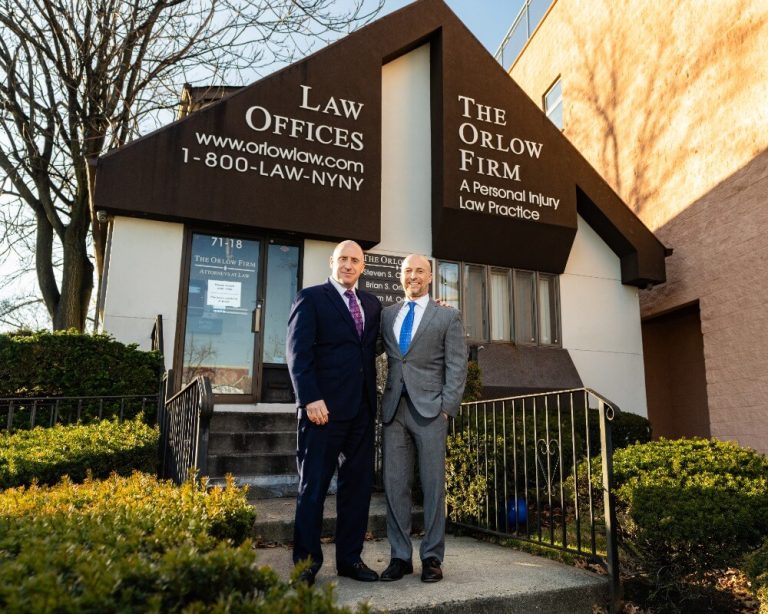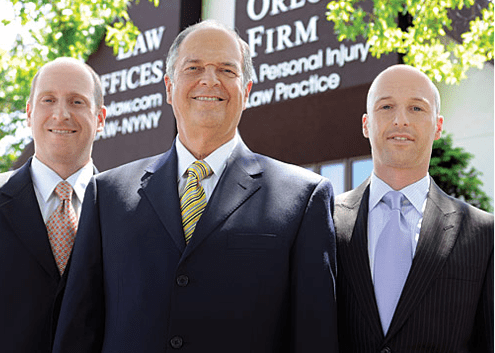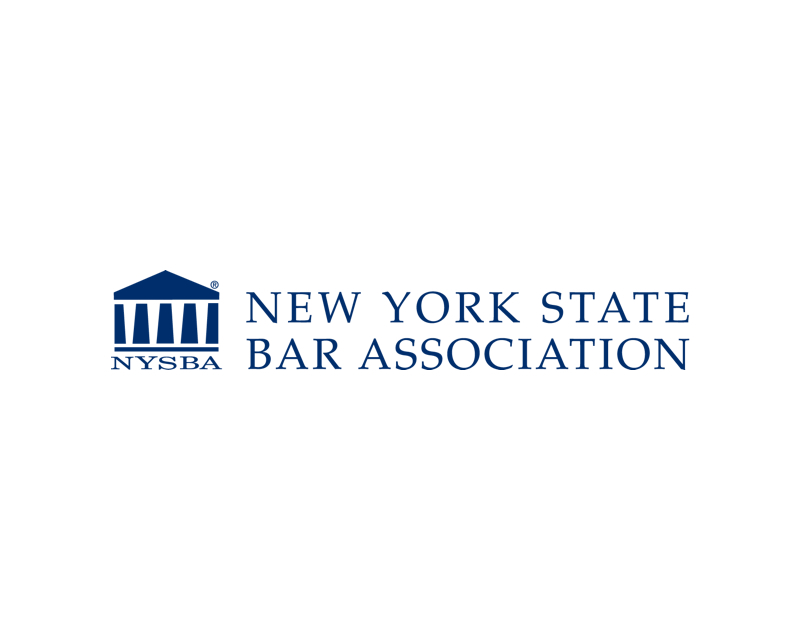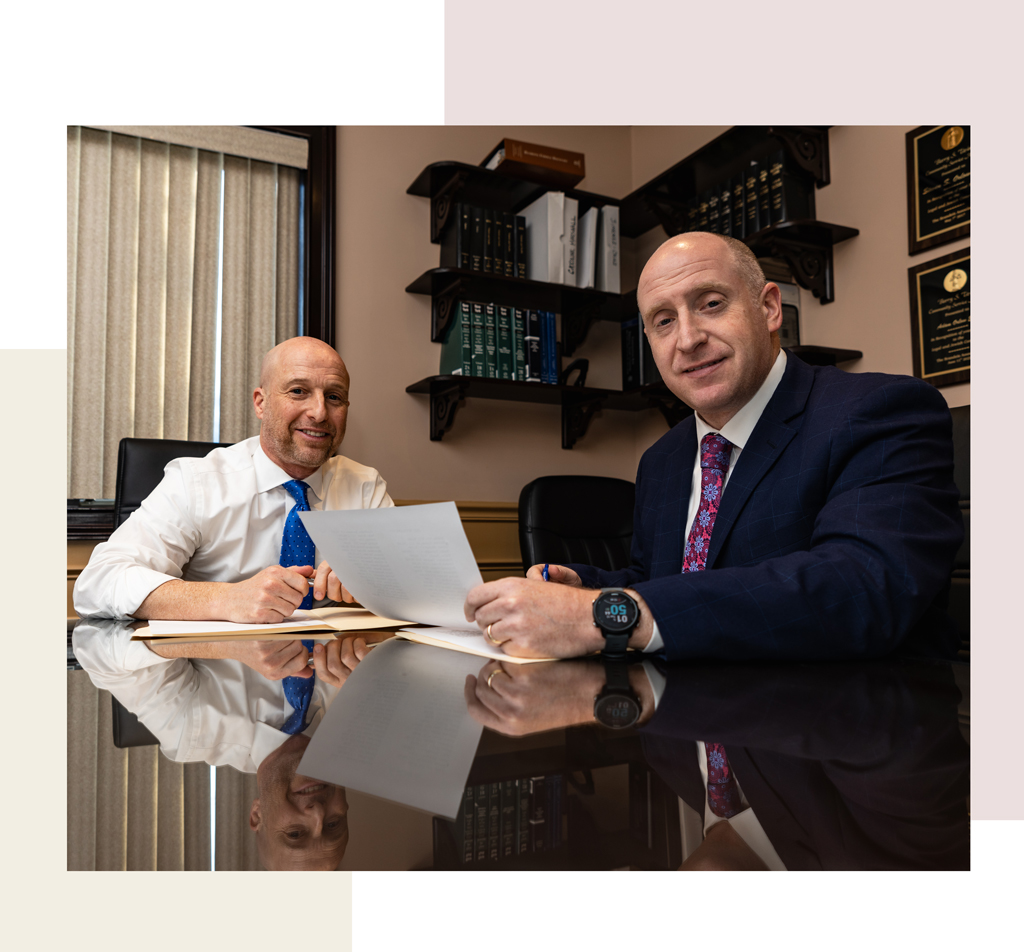The Following People Contributed to This Page
Lorem ipsum dolor sit amet, consectetur adipiscing elit. In erat enim, efficitur vel mauris in, ullamcorper dapibus sem. In a sodales lectus, ut laoreet justo. Sed auctor malesuada tellus in luctus. Vestibulum sed lectus id sem tempor finibus vel non mauris. Duis at purus nec lacus rutrum imperdiet. Morbi dictum lorem et ullamcorper facilisis. Morbi consectetur magna felis. Aliquam facilisis vitae nibh ac imperdiet.
Read More
- June 23, 2025
What Does Preponderance of the Evidence Mean in a Civil Lawsuit?
Quick Answer: In New York civil lawsuits, the term “preponderance of the evidence” refers to the standard of proof that the plaintiff must meet to win their case. It means the plaintiff needs to convince the judge or jury that it is more likely than not that their claims are true. Essentially, the evidence presented by the plaintiff must be more convincing and create a greater than 50% probability that their version of events is accurate.
Here’s a more detailed explanation:
- Standard of Proof: In civil cases, the plaintiff carries the burden of proof, meaning they must present evidence to support their claims. This standard is what they must achieve for their arguments to be accepted by the court.
- More Likely Than Not: This means the “preponderance of the evidence” standard requires the plaintiff to show that their version of events is more likely true than not true. It is often visualized as the scales of justice tipping, even slightly, in the plaintiff’s favor.
- Probability: It can also be understood as the plaintiff needing to demonstrate a greater than 50% probability that their claim is valid and that the facts as they present them are accurate.
- Examples:
- In a personal injury case, this means the plaintiff must prove it is more likely than not that the defendant’s negligence caused their injuries.
- In a contract dispute, the plaintiff must prove it is more probable that the defendant breached the contract.
- Contrast with Criminal Cases: This standard is distinctly different from the “beyond a reasonable doubt” standard used in criminal cases, which requires a much higher level of certainty before a conviction can be made.
Were you injured in an accident in New York City? Get answers and a free case evaluation from our experienced personal injury lawyers at (646) 647-3398.
How Is Preponderance of the Evidence Used in New York Civil Cases?
In New York civil cases, the term “preponderance of the evidence“ is the legal standard used to decide who wins a lawsuit. This standard applies in most civil matters, including personal injury cases, slip and falls, car accidents, and more. It does not apply in criminal cases, which use a higher standard called “beyond a reasonable doubt.”
So, what does “preponderance of the evidence” actually mean? In simple terms, it means more likely than not. If one party’s facts and evidence are just a little stronger or more convincing than the other side’s, that party wins the case.
Imagine a scale tipping. If the plaintiff (the person bringing the case) shows even slightly more evidence than the defendant, the scale tips in their favor. That’s enough to meet the preponderance standard. It doesn’t have to be much—just more than 50% likely to be true.
Here’s how the standard is used in a typical New York City civil case:
- The judge or jury looks at all the facts presented by both sides.
- They decide which side is more believable , even if by just a small margin.
- If the plaintiff’s version is more likely true than not true, they win the case.
For example, in a personal injury claim after a car accident in Brooklyn, the injured person must show that it’s more likely than not that the driver caused the crash by being careless. They don’t have to prove it beyond all doubt—just that it’s more probably true than not.
In New York courts, this standard helps resolve cases fairly, especially when there are no clear witnesses or if both people tell different stories. It gives the opportunity to win even when the facts are shared between both sides, as long as your side is just a little stronger.
Were you injured in an accident in New York City? Get answers and a free case evaluation from our experienced personal injury lawyers at (646) 647-3398.
Why Is the Standard of Proof Lower in Civil vs. Criminal Cases?
The standard of proof is different in civil and criminal cases because the goals of these cases are very different. In a criminal case, the state is trying to punish someone for breaking the law. Because the stakes are so high—like going to jail—the law requires a higher level of proof: “beyond a reasonable doubt.” This means the jury or judge must be almost certain the person is guilty before they can convict.
In a civil case, the purpose is to settle a dispute between private parties, like individuals or businesses. These cases often involve money or compensation for harm, like in personal injury lawsuits. Because no one’s freedom is at risk, the proof needed is lower. The standard is called preponderance of the evidence, and it means that something is more likely true than not—just over 50% likely.
Here’s a simple way to think about it:
- Criminal Case: The prosecutor must prove the defendant is guilty “beyond a reasonable doubt.”
- Civil Case: The person bringing the lawsuit (the plaintiff) must show it is more likely than not that what they are claiming is true.
For example, in a personal injury case in New York City, the injured person only needs to convince the court that the other party was more likely than not responsible for the injury. They don’t need to prove the case with absolute certainty.
This lower standard in civil cases is important because it helps injured people get justice and compensation without having to meet an extremely high legal bar. That said, it still takes strong evidence—like photos, medical records, or witness statements—to meet the “more likely than not” requirement.
Were you injured in an accident in New York City? Get answers and a free case evaluation from our experienced personal injury lawyers at (646) 647-3398.
What Types of Evidence Can Help Meet the Preponderance Standard?
To prove your case in a New York civil lawsuit, you need to show that it is more likely than not that your side is true. This is called the preponderance of the evidence. You don’t have to prove your case beyond a reasonable doubt (that’s for criminal cases), but you do need solid evidence to tip the scale in your favor. Different types of evidence can help meet this standard, especially in personal injury cases in New York City.
Here are the main types of evidence that can help:
- Witness Testimony: This includes statements from people who saw the incident or know key facts. For example, a bystander who saw a car hit you in a crosswalk may be very helpful.
- Medical Records: These show the extent of your injuries and when they happened. They can link your injury to the incident, which is important in proving your claim.
- Photographs and Videos: Visual evidence can be powerful. Photos of your injuries, damage to property, or the scene where it happened can clearly show what took place.
- Police Reports: If the police responded to the incident, their report can be a reliable source of details. It may include officer observations and names of involved parties.
- Expert Opinions: Experts, like doctors or accident reconstruction specialists, can explain technical matters. Their opinions can support your version of events.
- Surveillance Footage: In NYC, many streets and businesses are covered by cameras. Video from traffic lights or stores can show exactly what happened leading up to the injury.
- Emails, Texts, and Other Documents: Written communication can also be useful. For example, a message where someone admits fault or describes how the injury occurred can support your case.
In New York civil courts, the goal is to show that your version of events is more believable than the other side’s. Even a small edge in credibility or the weight of evidence can be enough to win. Because of this, every piece of evidence matters.
If you’re involved in a personal injury case in New York City, gathering this kind of evidence early is important. The sooner the facts are collected, the stronger your case may be under the preponderance of the evidence standard. To get help securing and presenting the right evidence, contact The Orlow Firm at (646) 647-3398 for a free consultation.
Who Has the Burden of Proof in a NYC Civil Lawsuit?
In a New York City civil lawsuit, the person who files the lawsuit—called the plaintiff—has the burden of proof. This means the plaintiff must show that their claim is more likely true than not. This legal level of proof is known as the preponderance of the evidence.
Think of it like a scale. If one side has even a little more convincing evidence than the other, that side wins. The plaintiff doesn’t need to prove their case beyond all doubt. They just have to tip the scale slightly in their favor.
For example, in a personal injury case in NYC, if a person sues after being hit by a car, they must prove that the driver was more likely at fault than not. This might involve showing traffic camera footage, witness statements, or medical records. If the jury or judge believes the plaintiff’s version is more believable, even by just 51%, then the plaintiff has met the burden of proof.
The defendant—the person being sued—does not have to prove they did nothing wrong. But they can challenge the plaintiff’s evidence. They might provide their own proof or argue that the plaintiff’s evidence is weak or unreliable.
In summary:
- The plaintiff has the burden of proof in NYC civil cases.
- They must prove their case by a preponderance of the evidence.
- The defendant can defend themselves but does not have to prove anything unless raising certain defenses (like self-defense or consent).
Understanding who carries the burden of proof is important in personal injury claims and other civil matters. It affects what evidence is needed and how cases are decided in New York courts.
Were you injured in an accident in New York City? Get answers and a free case evaluation from our experienced personal injury lawyers at (646) 647-3398.
How Does Preponderance of the Evidence Impact Personal Injury Claims in NYC?
In personal injury cases in New York City, the term “preponderance of the evidence” plays a major role in whether a victim receives compensation. This standard is used to decide if the injured person, called the plaintiff, has shown that the other party is legally responsible for their injuries.
Under this rule, the plaintiff must prove that their version of what happened is more likely true than not. It means “more than 50%”—think of it like tipping a scale. If the evidence slightly favors one side, even just a little, that side wins.
In NYC, this standard applies to all types of personal injury claims, including:
- Car accidents
- Slip and falls on sidewalks or inside buildings
- Construction site injuries
- Premises liability, like unsafe conditions in stores or housing units
Here’s how preponderance of the evidence affects these cases:
- You don’t need to prove your case beyond all doubt —just that it’s more likely than not that the other party caused your injury.
- Collecting strong evidence matters . Photos, eyewitness statements, medical records, and expert reports can help show what really happened.
- Even small details can tip the scale . If your case is evenly matched, one extra piece of proof could make a big difference.
For example, imagine you slipped on a wet floor at a grocery store in Queens. You’ll need to show it’s more likely than not that:
- The store knew or should have known about the wet floor,
- They failed to clean it or warn customers , and
- You were hurt as a result .
If your photos show no warning signs and your doctor connects your injury directly to the fall, that may be enough to meet the standard.
Ultimately, the preponderance of the evidence standard allows injured people in NYC to pursue justice even without perfect proof. You just need to show that your story is more believable than the other side’s. If you think you may have a claim but aren’t sure how to prove it, you can call The Orlow Firm at (646) 647-3398 for a free consultation.
What Happens If the Evidence Is Equal on Both Sides?
In a New York City civil lawsuit, if the evidence is equal on both sides, the person bringing the case (called the “plaintiff”) usually loses. This is because the plaintiff has what’s known as the burden of proof, which means they must show their side is more likely true than not. This level of proof is called a preponderance of the evidence.
In simple terms, a preponderance of the evidence means “more likely than not.” It’s like tipping a scale. If the evidence is 51% in favor of the plaintiff and 49% against, the scale tips, and they win. But if the scale is perfectly balanced—meaning the evidence is 50/50—then it hasn’t tipped, and the plaintiff has not met the burden of proof.
Here’s an example:
- Plaintiff: Says they slipped and fell in a grocery store because the floor was wet and had no sign warning customers.
- Defendant: Says the floor was clean and dry at the time, and no incident was reported until hours later.
If both sides give equally believable stories, and there is no clear photo, video, or witness to lean either way, the court sees the case as tied. Because the plaintiff did not prove it was “more likely than not” that the store was at fault, the defendant wins the case.
This rule applies in all New York City civil courts. If you’re suing someone or being sued, it’s crucial to gather strong, clear evidence. Even if your story is true, if the court can’t see enough proof to tip the scale in your favor, you may not win.
If you’re not sure whether your evidence meets the preponderance standard, or if you need help building a strong case, call The Orlow Firm for a free consultation at (646) 647-3398.
FAQ: Preponderance of the Evidence in New York Civil Cases
- What does “preponderance of the evidence” mean?
This term means that one side has shown that their version of events is more likely true than not. In simple terms, if something is more than 50% likely to be true, it can meet the preponderance standard. It’s used in civil cases, like personal injury lawsuits, not criminal ones. - Is the “preponderance of the evidence” the same as “beyond a reasonable doubt”?
No, these are very different. “Beyond a reasonable doubt” is used in criminal trials and is a much higher standard. The “preponderance of the evidence” just means more likely than not — around 51% or more. It’s the standard used in most civil cases in New York, including personal injury claims. - Who decides if the preponderance standard is met?
In most civil cases, the judge or jury decides. They look at all the evidence presented and determine which side’s version of events is more believable. If the injured person (the plaintiff) meets the preponderance standard, the court may award damages. - Does the plaintiff have to prove everything with evidence?
The plaintiff must prove the main parts of their case with evidence. This includes showing the other party was negligent (careless), the negligence caused harm, and that there were real damages like medical bills or lost wages. The more solid the proof, the better the chances of meeting the preponderance standard. - What kind of evidence is used to meet the standard?
Many types of evidence can help, including:- Medical records showing injuries and treatment
- Photos or videos from the accident scene
- Witness statements
- Police reports
- Expert opinions (like from doctors or accident experts)
- What happens if both sides present equal evidence?
If the evidence is equally balanced, the side that has the burden of proof — usually the plaintiff — loses. That’s because they didn’t tip the scale in their favor, even slightly. They must show their side is more likely true to win the case. - Is this standard used in all civil cases in New York?
Yes, most civil cases in New York, including personal injury lawsuits, use the preponderance of the evidence standard. It’s the normal level of proof in civil court, unlike in criminal court where the standard is higher. - How can I know if I’ve met the preponderance standard in my case?
It can be hard to judge on your own. A personal injury attorney can help review the details of your case and your evidence. They can guide you on whether your case may meet the preponderance standard or what more is needed.
Were you injured in an accident in New York City? Get answers and a free case evaluation from our experienced personal injury lawyers at (646) 647-3398.
Need Help Proving Your Case? Contact The Orlow Firm for a Free Consultation

In a civil lawsuit, the person bringing the case (called the plaintiff) needs to prove their claim by a “preponderance of the evidence.” This means they must show that their side of the story is more likely true than not. If you’ve been injured in New York City, proving your case can be difficult without the right support. The Orlow Firm is here to help guide you through this process.
Proving a case by a preponderance of the evidence is different from how criminal cases work. In criminal court, the standard is “beyond a reasonable doubt,” which is much higher. In civil cases, like personal injury lawsuits, you only need to tip the scale slightly in your favor. Even 51% proof is enough. Still, it takes carefully gathered facts, strong documentation, and clear legal arguments.
At The Orlow Firm, we work closely with clients to help build a strong case. This includes:
- Collecting evidence like accident reports, photos, medical records, and witness statements
- Speaking with experts such as doctors or accident reconstruction specialists to support your claims
- Making sure deadlines are met so that your case isn’t dismissed for technical reasons
- Preparing you for testimony if needed, so your side of the story is presented clearly and truthfully
If you’re unsure whether you have enough evidence, or if you’re feeling overwhelmed by the legal process, it’s important to talk to an attorney. The burden of proof belongs to you, the injured person, and having the right legal team can make a big difference.
You don’t have to figure it out on your own. If you’ve been hurt and believe someone else is at fault, contact The Orlow Firm for a free consultation at (646) 647-3398. Our attorneys can review your situation and explain your legal options in plain, easy-to-understand terms.
We’re here to support you through every step of your personal injury case in New York City. Call today to get started.
The Following People Contributed to This Page
Lorem ipsum dolor sit amet, consectetur adipiscing elit. In erat enim, efficitur vel mauris in, ullamcorper dapibus sem. In a sodales lectus, ut laoreet justo. Sed auctor malesuada tellus in luctus. Vestibulum sed lectus id sem tempor finibus vel non mauris. Duis at purus nec lacus rutrum imperdiet. Morbi dictum lorem et ullamcorper facilisis. Morbi consectetur magna felis. Aliquam facilisis vitae nibh ac imperdiet.
Read More









